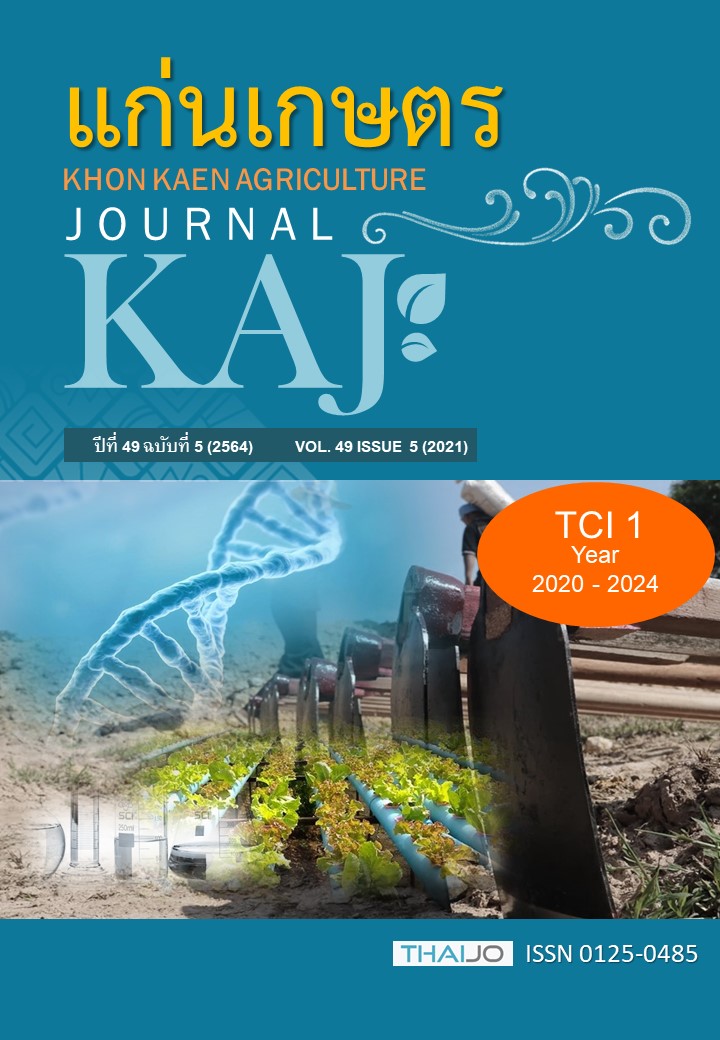ผลของแสงธรรมชาติและแสงจาก light-emitting diode (LED) ต่อประสิทธิภาพการสังเคราะห์แสงและลักษณะอื่นที่เกี่ยวข้องในข้าว
Main Article Content
บทคัดย่อ
การศึกษาเปรียบเทียบความแตกต่างระหว่างการปลูกข้าวภายใต้แสงธรรมชาติและแสง light-emitting diode (LED) ที่ส่งผลต่อประสิทธิภาพการสังเคราะห์แสง และลักษณะอื่นที่เกี่ยวข้องในข้าวพันธุ์ไทย วางแผนการทดลองแบบ split plot in complete randomized design (split plot in CRD) จำนวน 5 ซ้ำ โดยมีปัจจัยหลักคือแหล่งกำเนิดแสง 2 ประเภท คือ แสงจากธรรมชาติ (700-950 µmol/m2/s) และ แสง LED (850-1,000 µmol/m2/s) ปัจจัยรองคือ พันธุ์ข้าว 5 พันธุ์ ได้แก่ ไรซ์เบอรี่ (RB), กข10 (RD10), ชัยนาท1 (CN1), พิษณุโลก2 (PSL2) และหอมสุพรรณบุรี (HOM-SP) จากผลการทดลองพบว่า ข้าวที่ปลูกภายใต้แสง LED แสดงค่าประสิทธิภาพการสังเคราะห์ด้วยแสงสูงสุด (Fv/Fm) ได้สูงกว่า โดยมีค่าเฉลี่ยเท่ากับ 0.788 เมื่อเปรียบเทียบกับข้าวที่ปลูกในสภาวะแสงธรรมชาติ ซึ่งมีค่าเฉลี่ยเท่ากับ 0.72 ค่าความเขียวใบ (SPAD) ของข้าวที่ปลูกภายใต้แสง LED มีค่ามากกว่าต้นข้าวที่ปลูกในสภาพแสงธรรมชาติ โดยมีค่าเฉลี่ยเท่ากับ 43.75 และ 33.85 SPAD unit ตามลำดับ ค่าเฉลี่ย คลอโรฟิลล์ a, b และ คลอโรฟิลล์รวม มีความแตกต่างกันอย่างมีนัยสำคัญทางสถิติระหว่างพันธุ์ข้าว และระหว่างสภาพการให้แสง พบความแปรปรวนของปริมาณคลอโรฟิลล์ a และ b ในข้าวที่ปลูกภายใต้แสง LED มากกว่าแสงธรรมชาติในพันธุ์ HOM-SP RBและ RD10 ลักษณะของอัตราการถ่ายทอดอิเล็กตรอน (ETR) ในข้าวที่ปลูกภายใต้แสง LED และแสงธรรมชาติมีความแตกต่างกัน โดยต้นข้าวที่ปลูกภายใต้แสง LED มีค่า ETR สูงกว่าการปลูกภายใต้แสงธรรมชาติ โดยมีค่าระหว่าง 2.98 – 186.82 µmol/m2/s และ 1.416 – 88.169 µmol/m2/s ตามลำดับ จากการศึกษาครั้งนี้แสดงให้เห็นว่าแสง LED มีอิทธิพลต่อการเพิ่มประสิทธิภาพการสังเคราะห์แสงและลักษณะอื่นๆ ที่เกี่ยวข้องกับกระบวนการสังเคราะห์แสงในข้าว เช่นเดียวกับปฏิสัมพันธ์ระหว่างพันธุ์ข้าวและสภาพแวดล้อม
Article Details

อนุญาตภายใต้เงื่อนไข Creative Commons Attribution-NonCommercial-NoDerivatives 4.0 International License.
เอกสารอ้างอิง
นงลักษณ์ พยัคฆศิรินาวิน, อุบล ชินวัง, และสุวัฒน์ ธีระพงษ์ธนากร. 2557. การประยุกต์ใช้เทคนิคคลอโรฟิลล์ฟลูออเรสเซ็นท์กับพืชสวน. การเกษตรราชภัฏ. 13: 37-46.
พิชญ์สินี เพชรไทย, และธรรมศักดิ์ ทองเกตุ. 2560. ผลของความเข้มแสงและระยะเวลารับแสงต่อการเจริญเติบโตและคุณภาพของผักกาดหอม. วารสารพืชศาสตร์สงขลานครินทร์. 4: 54-59.
ทิวา จามระรี, ปารวี กาญจนประโชติ, สมเกียรติ จรุรงค์ล้ำเลิศ และสริริวัฒน์ สาครวาสี. 2560. อิทธิพลของแสงไฟแอลอีดีต่อการเจริญเติบโตของต้นพิทูเนียพันธุ์ Purple ภายใต้ระบบการปลูกพืชแบบกึ่งปิด. น. 184-191. ใน: ประชุมวิชาการระดับชาติ พิบูลสงครามวิจัย ครั้งที่ 3 ประจำปี พ.ศ. 2560 วันที่ 23 – 24 มีนาคม 2560. คณะวิทยาศาสตร์และเทคโนโลยี มหาวิทยาลัยราชภัฏพิบูลสงคราม, พิษณุโลก.
สมาคมผู้ส่งออกข้าวไทย. 2561. สรุปสถานการณ์ส่งออกข้าวไทยปี 2660 และแนวโน้มและทิศทางการส่งออก ข้าวไทยปี 2561. สมาคมผู้ส่งออกข้าวไทย. แหล่งข้อมูล: http://www.thairiceexporters.or.th. ค้นเมื่อ 3 กันยายน 2562.
Arnon, D. I. 1949. Copper enzymes in isolated chloroplasts, polyphenolexidase in beta vulgaris. Plant Physiology. 24: 1–15.
Baker, N. R. 2008. Chlorophyll fluorescence: a probe of photosynthesis in vivo. Annual Review of Plant Biology. 59: 89–113.
Brown, T.B., R. Cheng, X.R. Sirault, T. Rungrat, K.D. Murray,M. Trtilek, R.T. Furbank, M. Badger, B.J. Pogson, and J.O. Borevitz. 2014. TraitCapture: genomic and environment modelling of plant phenomic data. Current Opinion in Plant Biology. 18: 73–79.
Chen, C.C., M.Y. Huang, K.H. Lin, S.L. Wong, W.D. Huang, and C.M. Yang. 2014. Effects of light quality on the growth, development and metabolism of rice seedlings (Oryza sativa L.). Research Journal of Biotechnology. 9: 15-24.
Ghosh, M., D.K. Swain, M.K. Jha, V.K. Tewari, and A. Bohra. 2020. Optimizing chlorophyll meter (SPAD) reading to allow efficient nitrogen use in rice and wheat under rice-wheat cropping system in eastern India. Plant Production Science. 23: 270-285.
Hasan, M.M., T. Bashir, R. Ghosh, S.K. Lee, and H. Bae. 2017. An overview of LEDs’ effects on the production of bioactive compounds and crop quality. Molecules. 22: 1420.
Kobayashi, K., T. Amore, and M. Lazaro. 2013. Light-Emitting Diodes (LEDs) for miniature hydroponic lettuce. Optics and Photonics Journal. 3: 74–77.
Kumagai, E., A. Araki, and F. Kubota. 2009. Correlation of chlorophyll meter readings with gas exchange and chlorophyll fluorescence in flag leaves of rice (Oryza sativa L.) Plant Production Science. 12: 50–53.
Kozai, T. 2013. Plant factory in Japan - current situation and perspectives. Chronica. Horticulture. 53: 8-11.
Krause, G., and E. Weis. 1991. Chlorophyll fluorescence and photosynthesis: The basics. Annual Review of Plant Physiology and Plant Molecular Biology. 42: 313–349.
Li, Y., Y. Gao, X. Xu, Q. Shen, and S. Guo. 2009. Light-saturated photosynthetic rate in high nitrogen rice (Oryza sativa L.) leaves is related to chloroplastic CO2 concentration. Journal of Experimental Botany. 60: 2351–2360.
Liu, Q.H., X. Wu, T. Li, J.M. Ma, and X.B. Zhou. 2013. Effects of elevated air temperature on physiological characteristics of flag leaves and grain yield in rice. Chilean journal of agricultural research. 73: 85-90.
Misra, A.N, M. Misra, and R. Singh. 2012. Chlorophyll Fluorescence in Plant Biology. P.176-190. In: Biophysics. Janeza Trdine 9, 51000 Rijeka, Croatia.
Pedrós, R., I. Moya, Y. Goulas, and S. Jacquemoud. 2008. Chlorophyll fluorescence emission spectrum inside a leaf. Photochemical and Photobiological Science. 7: 498–502.
Qu, M., G. Zheng, S. Hamdani, J. Essemine, Q. Song, H. Wang, C. Chu, X. Sirault, and X. Zhua. 2017. Leaf photosynthetic parameters related to biomass accumulation in a global rice diversity survey. Plant Physiology. 175: 248-258.
RStudio Team. 2019. RStudio: Integrated Development for R. RStudio, Inc. Massachusetts, USA. Available: http://www.rstudio.com/. Accessed March 2019
Rungrat, T., M. Awlia, T. Brown, R. Cheng, X. Sirault, J. Fajkus, M. Trtilek, B. Furbank, M. Badger, M. Tester, B.J. Pogson, J.O. Borevitz, and P. Wilson. 2016. Using Phenomic Analysis of Photosynthetic Function for Abiotic Stress Response Gene Discovery. The Arabidopsis Book. 14: e0185.
Shah, S.H., R. Houborg, and M.F. McCabe. 2017. Response of chlorophyll, carotenoid and spad-502 measurement to salinity and nutrient stress in wheat (Triticum aestivum L.). Agronomy. 7:61.
Wojciechowska, R., O. Dtugosz-Grochowska, A. Kotton, and M. Zupnik. 2015. Effects of LED supplemental lighting on yield and some quality parameters of lamb’s lettuce grown in two winter cycles. Scientia Horticulturae. 187: 80-86.
Yamori, W., G. Zhang, M. Takagaki, and T. Maruo. 2014. Feasibility study of rice growth in plant factories. Rice Research. 2: 119.
Yang, H., J. Yang, Y. Lv, and J. He. 2014. SPAD values and nitrogen nutrition index for the evaluation of rice nitrogen status. Plant Production Science. 17: 81-92.
Yuan, Z., Q. Cao, K. Zhang, S.T. Ata-Ul-Karim, Y. Tian, Y. Zhu, W. Cao, and X. Liu. 2016. Optimal leaf positions for SPAD meter measurement in rice. Frontiers in Plant Science. 7: 719.
Zhang, S.X., D.D. Huang, X.Y. Yi, S. Zhang, R. Yao, C.G. Li, A. Liang, and X.P. Zhang. 2016. Rice yield corresponding to the seedling growth under supplemental green light in mixed light-emitting diodes. Plant Soil and Environment. 62: 222-229.


